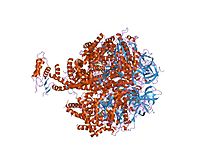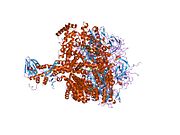ATP5E
| ATP5F1E | |||||||||||||||||||||||||||||||||||||||||||||||||||
|---|---|---|---|---|---|---|---|---|---|---|---|---|---|---|---|---|---|---|---|---|---|---|---|---|---|---|---|---|---|---|---|---|---|---|---|---|---|---|---|---|---|---|---|---|---|---|---|---|---|---|---|
 | |||||||||||||||||||||||||||||||||||||||||||||||||||
| Identifiers | |||||||||||||||||||||||||||||||||||||||||||||||||||
| Aliases | ATP5F1E,ATPE, MC5DN3, ATP synthase, H+ transporting, mitochondrial F1 complex, epsilon subunit, ATP synthase F1 subunit epsilon, ATP5E | ||||||||||||||||||||||||||||||||||||||||||||||||||
| External IDs | OMIM:606153;MGI:1855697;HomoloGene:128187;GeneCards:ATP5F1E;OMA:ATP5F1E - orthologs | ||||||||||||||||||||||||||||||||||||||||||||||||||
| |||||||||||||||||||||||||||||||||||||||||||||||||||
| |||||||||||||||||||||||||||||||||||||||||||||||||||
| |||||||||||||||||||||||||||||||||||||||||||||||||||
| |||||||||||||||||||||||||||||||||||||||||||||||||||
| |||||||||||||||||||||||||||||||||||||||||||||||||||
| Wikidata | |||||||||||||||||||||||||||||||||||||||||||||||||||
| |||||||||||||||||||||||||||||||||||||||||||||||||||
| Mitochondrial ATP synthase epsilon chain | |||||||||
|---|---|---|---|---|---|---|---|---|---|
 ground state structure of f1-atpase from bovine heart mitochondria (bovine f1-atpase crystallised in the absence of azide) | |||||||||
| Identifiers | |||||||||
| Symbol | ATP-synt_Eps | ||||||||
| Pfam | PF04627 | ||||||||
| InterPro | IPR006721 | ||||||||
| SCOP2 | 1e79/SCOPe/SUPFAM | ||||||||
| |||||||||
ATP synthase F1 subunit epsilon, mitochondrialis anenzymethat in humans is encoded by theATP5F1Egene.[5][6]The protein encoded by ATP5F1E is a subunit ofATP synthase,also known as Complex V. Variations of this gene have been associated with a condition called mitochondrial complex V deficiency, nuclear 3 (MC5DN3) andpapillary thyroid cancer.[7][8]
TheATP5F1Egene, located on the q arm ofchromosome 20in position 13.32, is made up of 3 exons and is 3,690 base pairs in length.[6]The ATP5F1E protein weighs 5.7 kDa and is composed of 51 amino acids.[9][10]Twopseudogenesof this gene are located on chromosomes 4 and 13.[6]
ATP5F1E is located on the rotating central stalk of ATP synthase, and can be contracted or extended. When it is contracted, it inhibits the ATP synthase active site, preventing ATP from being produced or degraded. It changes shape based on the rotation of the gamma subunit of the stalk, and is also thought to become extended in the presence ofADP,acting as a "safety lock" preventing the wasteful degradation of ATP.
Naming
[edit]This gene is named for the subunit it encodes of the version ofATP synthasefound inmitochondria.Mitochondrial ATP synthase catalyzes ATP synthesis through the difference in protein concentrations across a cellular membrane. ATP synthase is composed of two linked multi-subunit complexes, each composed of multiple proteins: the water-soluble catalytic core, F1,and themembrane-spanning component,Fo,comprising theproton channel.The catalytic portion of mitochondrial ATP synthase consists of 5 different kinds of subunits (alpha, beta, gamma, delta, and epsilon), each catalytic core containing 3 alpha, 3 beta, one gamma, one delta, and one epsilon. This gene encodes the epsilon subunit of the catalytic core.[6]
Function
[edit]Mitochondrial membrane ATP synthase (F1FoATP synthase or Complex V) producesATPfromADPin the presence of aproton gradient(difference in proton concentration) across the membrane generated by electron transport complexes of therespiratory chain.F-type ATPasesconsist of twostructural domainsor parts: F1,which contains the catalytic core outside of the membrane; and Fo,which contains the proton channel reaching across the membrane; both linked together by a central stalk and a peripheral stalk. During catalysis, ATP synthesis in the active site of F1is coupled, through a mechanism involving the rotation of the central stalk, to the motion of protons across the membrane. ATP5F1E is part of the F1domain, and more specifically part of the rotating central stalk. Rotation of the central stalk against the surrounding alpha3beta3subunits, leads to thehydrolysisof ATP in three separate catalytic sites on the beta subunits (Bysimilarity).[11][clarification needed]
Being located in the stalk region of the F1complex, the epsilon unit acts as aninhibitorof theactive siteof the ATPase. The epsilon subunit can assume twoconformations,or shapes: contracted and extended. The latter inhibits ATP hydrolysis, while the former does not. The conformation of the epsilon subunit is determined by the direction of rotation of the gamma subunit of the ATPase, and possibly by the presence of ADP. The epsilon subunit is thought to become extended in the presence of ADP, thereby acting as a safety lock to prevent the wasteful degradation of ATP to ADP throughhydrolysis.[12]
Clinical significance
[edit]Mutations in theATP5F1Egene cause mitochondrial complex V deficiency, nuclear 3 (MC5DN3), a mitochondrial disorder with heterogeneous clinical manifestations including dysmorphic features, psychomotor retardation,hypotonia,growth retardation,cardiomyopathy,enlarged liver,hypoplastic kidneysand elevated lactate levels in urine, plasma andcerebrospinal fluid.[7]Pathogenic variations have included a homozygous Tyr12Cys mutation in theATP5Egene, which has been linked with neonatal onset complex V deficiency withlactic acidosis,3-methylglutaconic aciduria,mildmental retardationand developedperipheral neuropathy.[13]
Reduced expression of ATP5F1E is significantly associated with the diagnosis ofpapillary thyroid cancerand may serve as an early tumor marker of the disease.[8]Papillary thyroid cancer is the most common type ofthyroid cancer,[14]representing 75 percent to 85 percent of all thyroid cancer cases.[15]It occurs more frequently in women and presents in the 20–55 year age group. It is also the predominant cancer type in children with thyroid cancer, and in patients with thyroid cancer who have had previous radiation to the head and neck.[16]
Interactions
[edit]ATP5F1E has been shown to have 34 binaryprotein-protein interactionsincluding 28 co-complex interactions. ATP5F1E appears to interact with ATP5F1D,AGTRAP,CYP17A1,UBE2N.[17]
References
[edit]- ^abcGRCh38: Ensembl release 89: ENSG00000124172–Ensembl,May 2017
- ^abcGRCm38: Ensembl release 89: ENSMUSG00000016252–Ensembl,May 2017
- ^"Human PubMed Reference:".National Center for Biotechnology Information, U.S. National Library of Medicine.
- ^"Mouse PubMed Reference:".National Center for Biotechnology Information, U.S. National Library of Medicine.
- ^Tu Q, Yu L, Zhang P, Zhang M, Zhang H, Jiang J, Chen C, Zhao S (April 2000)."Cloning, characterization and mapping of the human ATP5E gene, identification of pseudogene ATP5EP1, and definition of the ATP5E motif".The Biochemical Journal.347(1): 17–21.doi:10.1042/0264-6021:3470017.PMC1220925.PMID10727396.
- ^abcd"Entrez Gene: ATP5F1E ATP synthase F1 subunit epsilon".
- ^ab"ATP5F1E".Genetics Home Resource.NCBI.
- ^abHurtado-López LM, Fernández-Ramírez F, Martínez-Peñafiel E, Carrillo Ruiz JD, Herrera González NE (June 2015)."Molecular Analysis by Gene Expression of Mitochondrial ATPase Subunits in Papillary Thyroid Cancer: Is ATP5E Transcript a Possible Early Tumor Marker?".Medical Science Monitor.21:1745–51.doi:10.12659/MSM.893597.PMC4482184.PMID26079849.
- ^Zong NC, Li H, Li H, Lam MP, Jimenez RC, Kim CS, Deng N, Kim AK, Choi JH, Zelaya I, Liem D, Meyer D, Odeberg J, Fang C, Lu HJ, Xu T, Weiss J, Duan H, Uhlen M, Yates JR, Apweiler R, Ge J, Hermjakob H, Ping P (October 2013)."Integration of cardiac proteome biology and medicine by a specialized knowledgebase".Circulation Research.113(9): 1043–53.doi:10.1161/CIRCRESAHA.113.301151.PMC4076475.PMID23965338.
- ^"ATP synthase subunit epsilon, mitochondrial".Cardiac Organellar Protein Atlas Knowledgebase (COPaKB).[permanent dead link]
- ^"ATP synthase subunit epsilon, mitochondrial".UniProt.The UniProt Consortium.
 This article incorporates text from this source, which is available under theCC BY 4.0license.
This article incorporates text from this source, which is available under theCC BY 4.0license.
- ^Feniouk BA, Junge W (September 2005)."Regulation of the F0F1-ATP synthase: the conformation of subunit epsilon might be determined by directionality of subunit gamma rotation".FEBS Letters.579(23): 5114–8.doi:10.1016/j.febslet.2005.08.030.PMID16154570.S2CID84231010.
- ^Mayr JA, Havlícková V, Zimmermann F, Magler I, Kaplanová V, Jesina P, Pecinová A, Nusková H, Koch J, Sperl W, Houstek J (September 2010)."Mitochondrial ATP synthase deficiency due to a mutation in the ATP5E gene for the F1 epsilon subunit".Human Molecular Genetics.19(17): 3430–9.doi:10.1093/hmg/ddq254.PMID20566710.
- ^Hu MI, Vassilopoulou-Sellin R, Lustig R, Lamont JP"Thyroid and Parathyroid Cancers"Archived2010-02-28 at theWayback Machinein Pazdur R, Wagman LD, Camphausen KA, Hoskins WJ (Eds)Cancer Management: A Multidisciplinary ApproachArchived2013-10-04 at theWayback Machine.11 ed. 2008.
- ^Chapter 20 in:Mitchell, Richard Sheppard, Kumar, Vinay, Abbas, Abul K, Fausto, Nelson (2007).Robbins Basic Pathology.Philadelphia: Saunders.ISBN978-1-4160-2973-1.8th edition.
- ^Dinets A, Hulchiy M, Sofiadis A, Ghaderi M, Höög A, Larsson C, Zedenius J (June 2012)."Clinical, genetic, and immunohistochemical characterization of 70 Ukrainian adult cases with post-Chornobyl papillary thyroid carcinoma".European Journal of Endocrinology.166(6): 1049–60.doi:10.1530/EJE-12-0144.PMC3361791.PMID22457234.
- ^"34 binary interactions found for search term ATP5F1E".IntAct Molecular Interaction Database.EMBL-EBI.Retrieved2018-11-21.
Further reading
[edit]- Viñas O, Powell SJ, Runswick MJ, Iacobazzi V, Walker JE (January 1990)."The epsilon-subunit of ATP synthase from bovine heart mitochondria. Complementary DNA sequence, expression in bovine tissues and evidence of homologous sequences in man and rat".The Biochemical Journal.265(2): 321–6.doi:10.1042/bj2650321.PMC1136890.PMID2137333.
- Elston T, Wang H, Oster G (January 1998). "Energy transduction in ATP synthase".Nature.391(6666): 510–3.Bibcode:1998Natur.391..510E.doi:10.1038/35185.PMID9461222.S2CID4406161.
- Wang H, Oster G (November 1998). "Energy transduction in the F1 motor of ATP synthase".Nature.396(6708): 279–82.Bibcode:1998Natur.396..279W.doi:10.1038/24409.PMID9834036.S2CID4424498.
- Hu RM, Han ZG, Song HD, Peng YD, Huang QH, Ren SX, Gu YJ, Huang CH, Li YB, Jiang CL, Fu G, Zhang QH, Gu BW, Dai M, Mao YF, Gao GF, Rong R, Ye M, Zhou J, Xu SH, Gu J, Shi JX, Jin WR, Zhang CK, Wu TM, Huang GY, Chen Z, Chen MD, Chen JL (August 2000)."Gene expression profiling in the human hypothalamus-pituitary-adrenal axis and full-length cDNA cloning".Proceedings of the National Academy of Sciences of the United States of America.97(17): 9543–8.Bibcode:2000PNAS...97.9543H.doi:10.1073/pnas.160270997.PMC16901.PMID10931946.
- Gross C, Kussmann S, Hehr A, Hansmann I, Schlote D (2001). "Epsilon subunit gene of F(1)F(0)-ATP synthase (ATP5E) on human chromosome 20q13.2-->q13.3 localizes between D20S171 and GNAS1".Cytogenetics and Cell Genetics.91(1–4): 105–6.doi:10.1159/000056828.PMID11173840.S2CID19946536.
- Cross RL (January 2004)."Molecular motors: turning the ATP motor".Nature.427(6973): 407–8.Bibcode:2004Natur.427..407C.doi:10.1038/427407b.PMID14749816.S2CID52819856.
External links
[edit]- HumanATP5F1Egenome location andATP5F1Egene details page in theUCSC Genome Browser.
This article incorporates text from theUnited States National Library of Medicine([1]), which is in thepublic domain.









